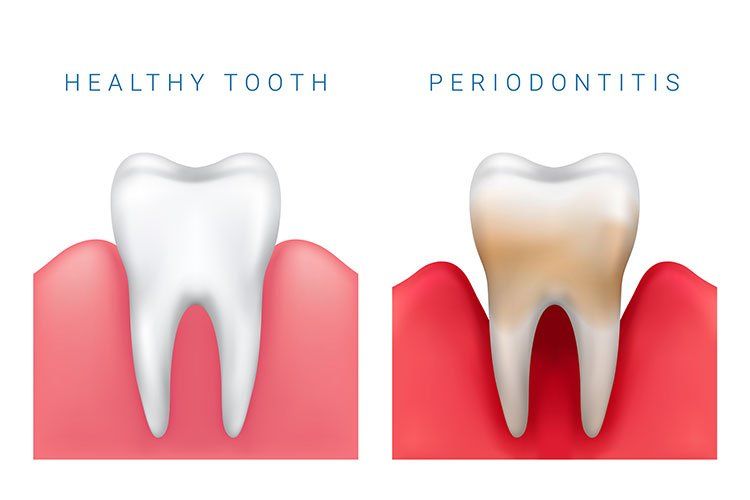Periodontics in Niles, IL
A periodontist is a dentist who specializes in the prevention, diagnosis, and treatment of periodontal disease, commonly known as gum disease. Gum disease is an oral inflammation caused by bacteria and if left untreated, can cause the loss of bone and teeth. Periodontists receive extensive training in order to treat and diagnose gum disease, including three years of additional education after completing their dental school.
Periodontists are called in to treat severe gum disease and are consulted on cases where a complex medical history is involved. A full list of medications and medical conditions are important to provide at the time of the appointment, as conditions such as diabetes, heart disease, and pregnancy can effect the treatment.
There are many treatments for periodontal disease, ranging from less invasive procedures like scaling and root planing (where the infected surface of the root is cleaned) or root surface debridement (where the damaged tissue is removed) to surgical procedures.
The goal is always to save the tooth and gum tissue, but in the event that the tooth must be removed for the overall health of the mouth, periodontists are trained in the placement of dental implants to save the surrounding bone and tissue.
Who Should See a Periodontist?
While a general dentist can manage early periodontal care and prevention, moderate to severe cases of periodontal disease are better referred to the specialist. Recent research suggests a correlation between gum disease and age related diseases like diabetes and heart disease. Someone with diabetes or heart disease is more lively to develop gum disease and should make sure to maintain regular visits to their general dentist to catch any problems before they become severe.
Here at Dental Specialist of Niles, the partnership between your general dentist and our periodontist is one to ensure the best gum health possible! Learn More
Our Services
Our Patient Experiences with Dental Implants
"Dental work can be a nightmare especially when is done on your gums. My experience with Dental Specialist of Niles was a smooth ride. I was having soft tissue graft done by Dr. Anasinski, excellent and passionate Periodontist always approaching you with smile and information that you need. Procedure required several office visits and each of them was timely and professional. Office has great and supportive staff than can assist you anytime, day or night. Thanks Dental Specialist of Niles for great job!"
Barbara K.
★★★★★
"Dr. Anasinski & her staff have taken care of my dental need, ie., crowns, root canal, implants, & gum Treatments over the last 5 years. They drilled into me the importance of dental hygiene which is done by their expert hygienist on a regular basis. I highly recommend Dr. Anasinski and her entire professional staff as they are caring, courteous, and highly knowledgeable! You are the best thank you! Toni A."
Toni A.
★★★★★
We Offer Complimentary Consultations
Periodontal Articles Written by Dr. Anasinki
-
Do You Have a High Risk Factor for Gum Disease?
According to the American Academy of Periodontology, there are certain factors that create a higher probability that a person will develop periodontal disease. Since gum disease is a condition that can exist without you even knowing you have it, being aware of the common risk factors associated with the disease can help you manage it if not prevent it all together.
Poor Dental Hygiene Habits
Not brushing at least twice a day and flossing at least once a day leaves your mouth extremely susceptible to gum disease because plaque that isn’t removed begins to build up in your mouth. When plaque is left undisturbed, it turns to tartar (also known as calculus) which manifests as hard deposits that build up on your teeth and under your gum line. These deposits create pockets where bacteria and particles can gather and become infected. While plaque can be removed with brushing, tartar can only be removed by a dentist using specialized tools.
Lack of Professional Dental Cleanings
As mentioned above, when tartar forms in your mouth, the only way it can be removed is with a professional dental cleaning. If these cleanings are not performed at least twice a year, the tartar buildup can lead to gum infections and disease.
Your Age
Research shows that periodontal disease is most prevalent in older people. Some of the reasons behind these statistics is that maintaining good oral hygiene habits can become more difficult as we age because of physical problems and challenges such as arthritis or lack of mobility. Larger handles on tooth brushes or battery operated toothbrushes are often a good choice for senior citizens.
Being a Woman
Because of the hormonal fluctuations and changes that your body goes through during different phases of your life, if you are a woman you are more susceptible to periodontal problems than your male counterparts. Even though women in general take better care of their teeth, the simple fact of being female creates a higher risk factor for gum disease.
Use of Tobacco Products
If you are a smoker or use tobacco products of any kind, you have a high probability of having gum disease sometime in your lifetime because studies indicate that tobacco use is one of the highest risk factors associated with periodontal disease.
Family Members with Periodontal Disease
There are two possible risk factors that exist for you if members of your family have or have had gum disease. First of all, studies show that as high as 30% of the population can be up to six times more likely to develop periodontal disease, so you could be genetically predisposed to contracting gum disease. The other factor involved is that the bacteria that cause gum disease can pass through saliva which can contribute to the risk factors for children and couples in households where one member has periodontal disease.
Certain Medications
Saliva is important for good oral health because it helps to manage bacteria that can contribute to gum disease, and some medications can reduce the flow of saliva in the mouth. Without enough saliva to keep bad bacteria at bay, they can flourish and cause periodontal problems.
Having a higher risk factor does not mean you are predestined to have gum disease, it simply means that you need to be much more vigilant with daily oral hygiene as well as visits to a dentist. The more you understand about your particular risk factors, the more you can take steps to help reduce your susceptibility to periodontal disease or other oral health problems.
-
Laser Periodontal Therapy
There are two main categories of gum disease: gingivitis and periodontitis. The first category can usually be treated with improved oral hygiene and professional dental cleanings. The second category, however, is more serious, usually involves infection and has typically required periodontal surgery to restore the gums to health. Now, however, there is another choice—periodontal laser therapy.
As gum disease advances, tartar forms and the sulcus, which is a pocket or space between the tooth and gums, becomes packed with bacteria, plaque, tartar and food particles, eventually turning into an infection. If left untreated, this infection not only destroys gum tissue but can also destroy the supporting bone structure that holds the tooth thus leading to tooth loss along with other health issues. Traditionally these infections have been treated with periodontal surgery which involves cutting into the gum to clean out the infection and then suturing the gum back together after the procedure is completed. This process may be uncomfortable and can take two to four weeks to completely recover.
With Laser Periodontal Treatment (LPT), most periodontal surgeries to treat gum infections could be avoided because a small laser fiber (equivalent to the size of three hairs) is placed between the tooth and the gum where the infection exists, and during the process it is used to remove the infected tissue. Because there are no sharp instruments or cutting involved with laser therapy, healthy tissue is left unharmed and the root of the tooth is not exposed which reduces sensitivity. Therefore, the overall process is virtually painless requiring only a local anesthetic. While performing the procedure, I also use the laser to ‘disturb’ the healthy tissue enough that it begins the process of reattaching to the bone which is something that does not take place with traditional periodontal surgery. In the final stage of the laser treatment, I use the laser to create a seal over the gum tissue to protect it from getting re-infected.
Traditional gum surgery requires four dental visits with additional follow-ups for suture removal and checking the area where the surgery was performed, but LPT requires only two sessions. The time for recovery is also greatly reduced from the typical two to four weeks to only twenty-four hours, with the patient being able to drive a car, go back to work or engage in any type of activity without worry or concern immediately after the procedure. Not only is LPT non-invasive with a quicker recovery time, it is also less expensive than periodontal surgery and most dental insurance companies will cover the cost.
While there is no cure for moderate to severe periodontitis, LPT can be used to effectively treat it, allowing the patient to remain healthy and live comfortably with the disease. And LPT is safe for people with health problems such as diabetes, hemophilia and HIV or those on medications such as Cyclosporin or Coumadin.
Periodontal disease has been linked to a variety of systemic diseases throughout the body, including cardiovascular disease, heart attack and stroke; therefore it needs to be treated, and LPT is currently the gentlest, least invasive treatment available.
-
Why Periodontal Care is Critical
Periodontal care – which refers to the care of the gums – is one of the most vital components of dental hygiene and one that is also significantly important to overall health. But many people do not fully understand the substantial role that periodontal health plays, and how the relationship between healthy gums and trouble-free teeth works. Because of that some may overlook their periodontal hygiene, for example, even though they are careful to maintain clean and sparkling teeth. Eventually, however, unless the gums are well taken care of on a daily basis the teeth with lose their strength, their whiteness, their luster, and their ability to withstand bacterial disease.
The gums or periodontal are comprised of soft tissue that guards and nurtures the teeth. So one of the primary functions of the gums is to buffer and protect the base of the tooth – where the vital root of the tooth is connected to the jaw – so that it is not susceptible to infection. In fact many of the problems that patients experience with their teeth actually begin in the periodontal region, and by being vigilant about caring for the gums it is possible to easily avoid many common tooth problems including decay.
When the gums are not healthy, they will often become swollen, tender, and bleed easily. It is much easier for bacterial infections to attack the the gums and bone which surround and support teeth (periodontium) – which are relatively soft and permeable – than it is for those germs to penetrate the hard enamel of the teeth. So many infections start in the gums, and as those spread and worsen the gums will begin to gradually recede away from the base of the teeth over time. That creates a gap or pocket between the tooth and gum where bacterial colonies grow stronger and eventually pierce the protective out layer of the tooth or burrow down underneath the tooth to attack the base of the tooth and the tooth’s root.
Once that kind of situation develops it can quickly accelerate and lead to serious consequences that require treatments including root canal procedures. Diseases of the gums can also spread into the bloodstream, where they are sometimes responsible for conditions including heart disease and other potentially deadly health care issues.
There are many modern treatments for periodontal disease, and dentists can even cure problems that are in advanced stages of infection by performing various periodontal surgical techniques. They can, for example, clean pockets of disease with tools including state-of-the-art lasers and then apply special dental antibiotics directly at the point of bacterial infection. Dentists can remove excess gum tissue when necessary, and they can also temporarily peel away gum in order to treat problems hidden behind the periodontal tissue deep within the base of a tooth.
But the best way for a dentist to help care for your gums and bone which surround and support teeth (periodontium) is with simple, painless, routine checkups. During your scheduled visits with your dental professional (the dentist, periodontist, or dental hygienist), he or she will ensure that the gums are carefully cleaned and checked. Measurements will be taken and recorded to make sure that any gaps between gums and teeth do not widen in an unhealthy manner, and your dental professional (dentist, periodontist or dental hygienist) can also advise you how to brush and floss correctly to ensure that your periodontal health is excellent and that your attractive smile lasts for many trouble-free years to come.
-
Periodontal Plastic Surgery
Periodontal Plastic Surgery Might Be Just The Process You’re Looking For
Each year more and more Americans are using cosmetic surgery to help them age gracefully or to repair or change features of their bodies with which they are not completely happy. And this trend involves dental procedures as well. According to a poll conducted by the American Academy of Periodontology, among the people they surveyed, smile enhancement procedures were higher on the list of cosmetic surgery than face lifts, and actually outnumbered eyelid surgeries as well.
While removing wrinkles or smile lines can help a person look younger, studies show that over 80% of people are not happy with their smile even when their faces are “wrinkle free.” Over 50% of people surveyed commented that they “consider the smile the first facial feature they notice.” For these reasons, periodontal plastic surgery “has experienced a significant shift toward cosmetic-related surgery to enhance smiles.”
But what exactly is periodontal plastic surgery? This term actually covers a variety of procedures and processes that your dentist can use to improve your teeth and enhance your smile. Since each person’s teeth and challenges to having a perfect smile are different, the processes involved in smile enhancement will be different as well. A visit to a cosmetic dentist can provide the options that are available to help in your particular case.
Some of the processes that a dentist can use are procedures like crown lengthening where excess gum tissue can be removed so that less gum and more teeth show when you smile. And if gum recession has occurred where your gum tissue has pulled away from your teeth showing your tooth root, soft tissue grafting can be performed to correct this problem. Or if you have missing teeth along the sides or in the back of your mouth and the jawbone has collapsed, creating a depression or concavity and giving the area around your mouth a “sunken look,” a cosmetic dentist can perform ridge augmentation to fill in the areas that are collapsed, which will in effect fill in the areas of your cheeks that are currently detracting from the beauty of your face.
Unattractive teeth can also be reshaped, contoured or covered as needed to restore or improve your smile. Dental implants can be used to replace missing teeth or to secure bridges, partials or even full dentures so that artificial teeth look, act and feel just like natural teeth. If you currently have dentures and you like the way they look, but their tendency to slip or ‘click’ when you talk causes you moments of discomfort, dental implants can secure your dentures to your jawbone, taking away any possibility of either slipping or clicking. Implant supported dentures look and function just like natural teeth.
Along with the dental processes that can cover, whiten, replace or correct your teeth, cosmetic dentists can also use dermal fillers to fill in any folds or creases in the skin around your mouth to complete the framework for your beautiful smile. Because dentists are practiced in the use of local anesthesia, the process of getting dermal fillers is often less uncomfortable when performed by a dentist.
So if you are looking for cosmetic procedures that can help you look young and feel wonderful, a cosmetic dentist could have the answers you are looking for.
Resources:
http://www.perio.org/commerce05/images/fcpls.pdf
-
The Truth About Gum Disease
There are a lot of fallacies or little known facts about periodontal disease that contribute to the fact that more than 75% of adults in the U.S. have some form of gum disease and most of them are unaware of the existing problem. Understanding the truth and facts about gum disease is a powerful tool for helping prevent any issues from developing.
Gum Disease is Serious
While often thought of as a “minor infection,” the reality is that the amount of tissue that exists in your mouth is equal to the amount of skin on your arm between your elbow and your wrist. Just imagine if that area on your arm got infected—it would definitely have an impact on your body. The same goes for any infection that takes hold in your gum tissue. In fact, studies reveal that whenever an infection exists anywhere in your body, C-Reactive Proteins (CRP) are created and these proteins irritate blood vessel walls which can result in narrowing of the arteries, cardiovascular disease, stroke or heart attack. The word “disease” should be a good indicator that a periodontal infection is not to be taken lightly.
In fact, in 2009 the American Journal of Cardiology published a consensus statement in which cardiologists and periodontists recommended the following:
- Patients with heart disease should have regular dental exams to check for signs of periodontal disease.
- Persons who have periodontal disease and at least one risk factor for heart disease should be evaluated for heart problems.
Bleeding or Tenderness in Gum Tissue is Not Normal
If your gums bleed when you brush your teeth or you experience tenderness in your gum tissue when you brush, floss or even bite or chew, those are signs that something is not right and you should see a dentist as soon as possible.
Gum Disease Can Exist Without You Knowing It
While some diseases or infections will give off warning signs in the early stages of the problem, gum disease isn’t one of them. Typically, by the time symptoms manifest, the disease is already destroying the bones and gum tissue that hold your teeth securely in your mouth. Regular dental checkups are the best way to ensure that gum disease has not taken hold in your mouth and is causing damage before any indications are present. Some of the most common signs to look for that can indicate a problem in your mouth are:
- Bad breath
- Tender, red or swollen gum tissue
- Gums that bleed during brushing or flossing
- Teeth that become loose to seem to have shifted
Periodontal Disease Causes More Tooth Loss Than Cavities
While many people believe that cavities are the number-one cause of tooth loss, that belief is erroneous. Recent studies now indicate that gum disease causes more issues than cavities on a ratio of more than 2 to 1.
The simple truth of the matter is that gum disease affects millions of American adults every year and left undiagnosed and/or untreated it can cause problems not only with your oral health but with your general health as well.
Treating Gum Disease Does Not Have to Be Painful
While at one time treating gum disease was a painful process, that is no longer the case. Because of new procedures, local anesthesia and over-the-counter products for dealing with any discomfort, the treatments used to treat periodontal diseases no longer have to be a painful experience.
-
Understanding Periodontitis
Another more technical term for the gums and bone that directly surround and support your teeth in your mouth is the Periodontium, also known as Periodontal Tissue. While the gums may seem to be nothing special – while the teeth do all the hard work of grinding, biting, and chewing – our gums are actually on guard and fighting all the time to preserve our dental health. Without the periodontal tissue we would not have protection around our teeth and the bones of the jaw that support the roots of teeth. Gums also help surround the teeth with nutrition, via the bloodstream, so they are actually a vital component of overall health.
When periodontal tissue gets infected, the first stage of that gum disease is called gingivitis. This level of infection is generally marked by swelling, some tenderness or soreness, and gums that bleed easily – for example when you rub against them with a toothbrush or stimulate them by flossing. All of these symptoms occur because of the presence of unwanted bacteria that creates a toxic environment within the gums themselves.
Treating that kind of gum problem is relatively easy and can sometimes be accomplished at home just by observing a good routine of oral hygiene including regular brushing, flossing, and eating of a healthy balanced diet. But left untreated minor gingivitis can suddenly erupt into a much more serious condition known as Periodontitis. At this stage the infection begins to deteriorate the gums, and as the gum tissue is destroyed it leaves an unhealthy gap or space around the base of the tooth. Left unguarded, this part of the tooth also gets infected, and it can start to lose its strength and density. If the situation progresses far enough the tooth will no longer have enough root substance or tightly surrounding gum tissue to keep it securely attached, and it will either fall out – leaving you with a missing tooth – or rot away until it needs to be extracted.
There are different stages of Periodontitis, and the aggressive stage is defined by this rapid loss of bone and teeth. Then there is chronic Periodontitis, which is probably the most common type of advanced gum disease. When in the chronic phase the gums start to recede or pull away from the teeth, leaving exposed spaces as we described earlier. There can also be Periodontitis that is fueled by other diseases such as heart disease or diabetes. Finally there is a condition known as Necrotizing Periodontal Disease. This form of gum disease creates lesions or tears in the gum tissue, creating open sores, and a very unsightly odor.
Of course none of these situations are good, and everyone wants to do whatever is necessary to avoid any form of periodontal disease. But the good news is that prevention of gum problems is easy – as long as you stick to a recommended program of dental hygiene, make regular visits to the Periodontist or Dentist for checkups, and live a generally healthy lifestyle. The easiest part of ensuring healthy Periodontium is just brushing and flossing and enjoying a healthy balanced diet – something that anyone can do on their own without having to spend lots of money, endure any special procedures, or take time to see your dental professional. If the gums do start to be sore or bleed, just give us a call and we can remedy your problem right away.
Kind Regards,
Dr. Anasinski






